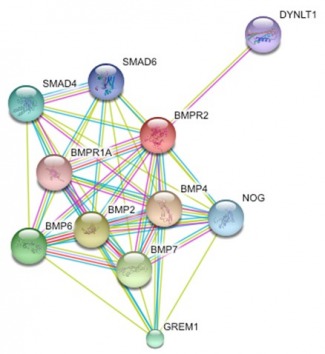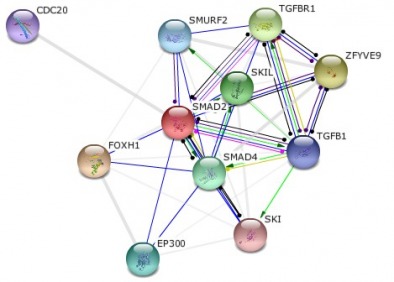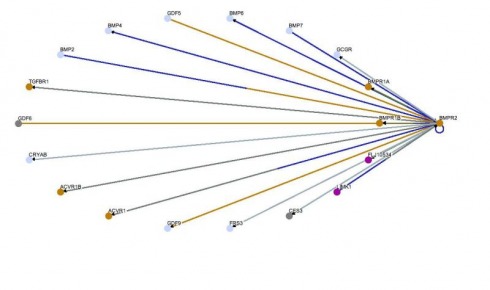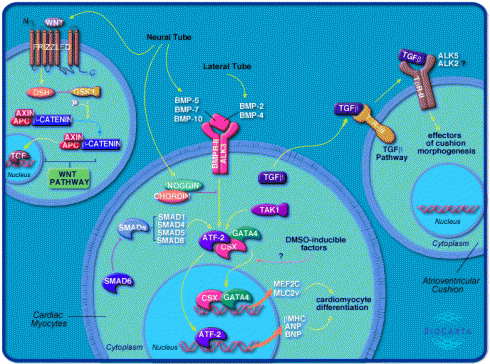This web page was produced as an assignment for Genetics 677, an undergraduate course at UW-Madison.
Protein interaction
Above information and figure retrieved from String
This is the protein-protein interaction network that was retrieved from String. Based on its literature value and database, it created the interaction with my interest of protein. Using String to create protein interaction is very helpful to understand my protein and disease much better, because it shows which proteins are involved with BMPR2. For example, BMPR1A interacts with BMPR2. Based on journals, when ligans bind (such as BMP2, BMP4, BMP6, or BMP6) to BMPR2, it is activated my being phosphorylated. As a result of conformational change, BMPR2 makes homodimer interaction with BMPR1A to phosphorylate and to activate (Morrell 2006). This protein phosphorylate other proteins as well, espeically SMAD1 to prevent smooth muscle cell proliferation (Yang et al 2005). After I read papers about smooth muscle cells and its relation to Smad signaling, I decided to creat another protein interaction of Smad2 (which has antagonistic characteristic) via String. Here is what I found:
This is the protein-protein interaction network that was retrieved from String. Based on its literature value and database, it created the interaction with my interest of protein. Using String to create protein interaction is very helpful to understand my protein and disease much better, because it shows which proteins are involved with BMPR2. For example, BMPR1A interacts with BMPR2. Based on journals, when ligans bind (such as BMP2, BMP4, BMP6, or BMP6) to BMPR2, it is activated my being phosphorylated. As a result of conformational change, BMPR2 makes homodimer interaction with BMPR1A to phosphorylate and to activate (Morrell 2006). This protein phosphorylate other proteins as well, espeically SMAD1 to prevent smooth muscle cell proliferation (Yang et al 2005). After I read papers about smooth muscle cells and its relation to Smad signaling, I decided to creat another protein interaction of Smad2 (which has antagonistic characteristic) via String. Here is what I found:
Based on what I found, Smad2 interacts with TGFBR1 instead of BMPR1. I would like to note about two proteins, which are Smurf2 and Smad4. Smurf2 degrades activated Smad2 in order to regulate the level of smooth muscle cell proliferation (Lin et al 2000). In addition, Smad2 binds to Smad4 to stimulate its transcription (Lin et al 2000).
Above inforatation and figure retrieved from Osprey
I also tried to look at protein interaction with Osprey. I found very similar protein interaction of BMPR2 as I got from String. For example, BMPR2 is most closely associated with BMPR1 because BMPR2 phosphorylates BMPR1 to activate for further signaling. There are various ligands, such as BMP7 or BMP4, that are binding to BMPR2. I found this this software useful in a way that I can keep constructing protein interaction beside my main protein of interest. For example, I could create BMPR2 protein interaction AND conduct further interaction of other proteins, such as TGF-br1. However, I could not see function of each protein as shown in String. If useful aspects from btoh String and Osprey can combine, it will be very useful to analyze protein interaction.
I also tried to look at protein interaction with Osprey. I found very similar protein interaction of BMPR2 as I got from String. For example, BMPR2 is most closely associated with BMPR1 because BMPR2 phosphorylates BMPR1 to activate for further signaling. There are various ligands, such as BMP7 or BMP4, that are binding to BMPR2. I found this this software useful in a way that I can keep constructing protein interaction beside my main protein of interest. For example, I could create BMPR2 protein interaction AND conduct further interaction of other proteins, such as TGF-br1. However, I could not see function of each protein as shown in String. If useful aspects from btoh String and Osprey can combine, it will be very useful to analyze protein interaction.
Above information and figure retrieved from Biocarta
Another interesting protein interaction is representing with more creative figure from Biocarta. What I received from Biocarta helped me alot for understanding the BMPR2 signaling pathway within a cell. Since there are so many priteins are interacted or are involved in BMPR2 signaling, I had a hard time to fully grasp how the actual pathway works. To summarize this figure, when ligands bind to BMPR2, further signlaing goes into cytoplasm and finally in nucleus for transcription. Smads are involved in this pathway. According to Morrell, Smad1 and 5 play an important role to inhibit the proliferation of smooth muscel cells (2006). It would be nice if the website provides function of each protein in addition to this descriptive signaling pathway of BMPR2.
Another interesting protein interaction is representing with more creative figure from Biocarta. What I received from Biocarta helped me alot for understanding the BMPR2 signaling pathway within a cell. Since there are so many priteins are interacted or are involved in BMPR2 signaling, I had a hard time to fully grasp how the actual pathway works. To summarize this figure, when ligands bind to BMPR2, further signlaing goes into cytoplasm and finally in nucleus for transcription. Smads are involved in this pathway. According to Morrell, Smad1 and 5 play an important role to inhibit the proliferation of smooth muscel cells (2006). It would be nice if the website provides function of each protein in addition to this descriptive signaling pathway of BMPR2.
Reference
[1] Morrell, N. (2006) Pulmonary Hypertension Due to BMPR2 Mutation. Proc Am Thorac Soc3, 680-686. doi: 10.1513/pats.200605-118SF
[2] Yang, X, Long, L., Southwood, M., Rudarakanchana, N., Upton, P., Jeffery, T., Atkinson, C., Chen, H., Trembath, R., & Morrell, N. Dysfunctional Smad Signaling Contributes to Abnormal Smooth Muscle Cell Proliferation in Familial Pulmonary Arterial Hypertension. Circulation Research 96, 1053-1063.
doi: 10.1161/01Res0000166926.54293.68
[3] Lin, X., Liang, M., Feng, X. (2000) Smurf2 is Ubiquitin E3 Ligase Mediating Proteasome-dependent Degrading of Smad2 in Transforming Growth Factor- β Signaling. Journal of Biological Chemistry, Vol 275, No 47, 36818-36822. doi 10.1074/jbc.C000580200
[1] Morrell, N. (2006) Pulmonary Hypertension Due to BMPR2 Mutation. Proc Am Thorac Soc3, 680-686. doi: 10.1513/pats.200605-118SF
[2] Yang, X, Long, L., Southwood, M., Rudarakanchana, N., Upton, P., Jeffery, T., Atkinson, C., Chen, H., Trembath, R., & Morrell, N. Dysfunctional Smad Signaling Contributes to Abnormal Smooth Muscle Cell Proliferation in Familial Pulmonary Arterial Hypertension. Circulation Research 96, 1053-1063.
doi: 10.1161/01Res0000166926.54293.68
[3] Lin, X., Liang, M., Feng, X. (2000) Smurf2 is Ubiquitin E3 Ligase Mediating Proteasome-dependent Degrading of Smad2 in Transforming Growth Factor- β Signaling. Journal of Biological Chemistry, Vol 275, No 47, 36818-36822. doi 10.1074/jbc.C000580200




